What are the Benefits of Paddle Boarding?
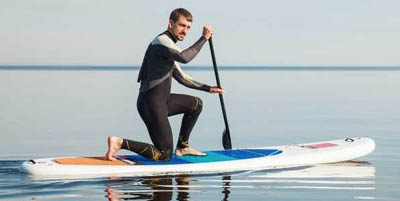
1. Paddle Boarding can Improve Mental Health
The first benefit that most people would think of would be physical, and yes this is very true and definitely has a strong place on this list, but for me personally and for many others, the mental benefits are huge.
It’s not just the working of the mind to get your body to coordinate. It’s the profoundly positive effect of being outdoors and connecting with nature that benefits your mental health.
This is true of most outdoor activities, but marry this with the levels of concentration and therapeutic effect of water, and you’ve got a winner.
2. Paddle Boarding Improves Physical Health
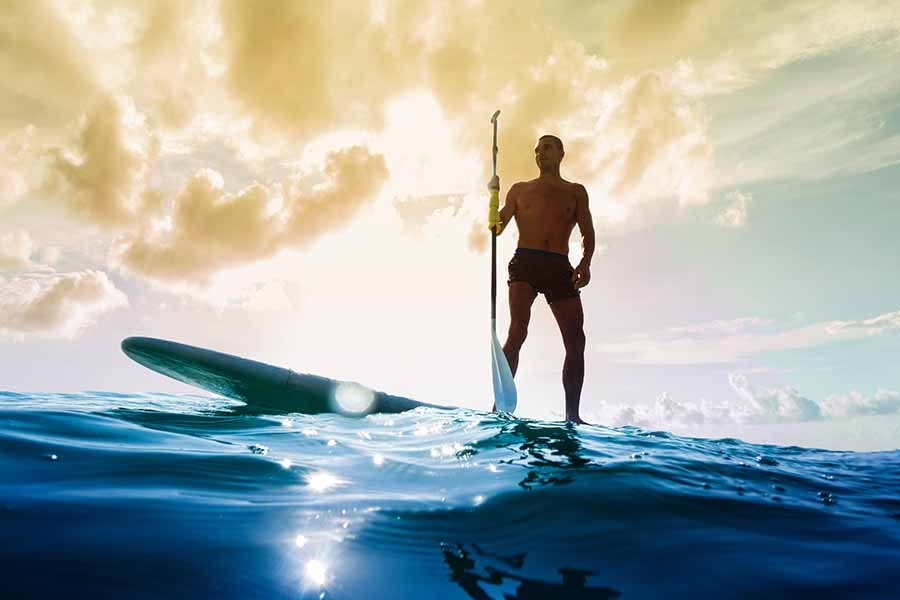
There are numerous health benefits aside from the mental aspect. Just being outdoors in the fresh air and giving your body the chance to absorb some vitamin D is going to boost your immune system.
The fitness aspect must not be under estimated. Try standing on a surfboard and then glide through the water using only a paddle. Balancing on a board on water requires engagement of your whole body.
What Muscles are used in Paddle Boarding?
You’ll need to use your glutes, abs, quads and other stabilizer muscles to keep you from getting wet.
You’ll need to use your upper body and rotational muscles to propel you through the water. The arms (Biceps & Triceps) pump the paddle, but it is the shoulders (Deltoids), back (Trapezius, Latissimus Dorsi & Rhomboids) and hips that give you the power to go the distance.
Is Paddle Boarding Good for your Core?
OMG YES! To maintain balance while paddling, your body engages all of your core muscles. The rotating motion of paddling on one side then the other aids the symmetrical development of muscles and strengthens obliques like no other.
3. Paddle Boarding is a Total Body Workout
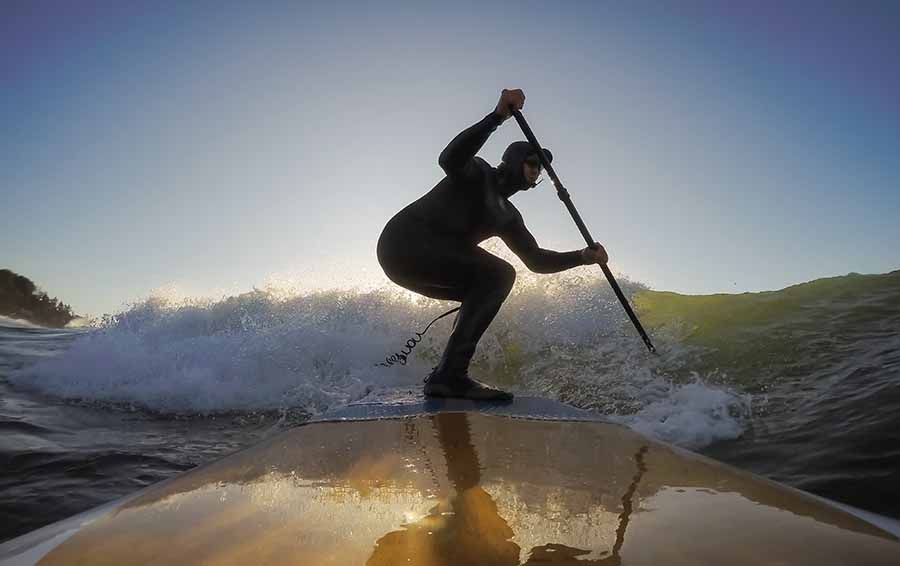
If you haven’t paddle-boarded before, get set for one of the best workouts you can have in an outdoor sport. It’s a total body engaging activity and it’s loads of fun. It’s a win on every level.
Is Paddle Boarding Good for Weight Loss?
Yes! Like any activity, you get out of it exactly what you put in. The more vigorous you approach it the more weight you’ll lose. Remember that weight loss is a simple calculation of calories consumed vs calories burned. If you go into a calorie deficit you are going to lose weight. Doing a sport like paddleboarding will certainly help you to achieve your weight loss goals.
How Many Calories Does Paddle Boarding Burn?
Again this is down to how aggressively you attack the activity. If you are paddling leisurely, (you can still hold a conversation with your fellow paddler) you can expect to burn through anything from 300 to 450 calories every hour.
If you’re doing something that’s more vigorous like SUP surfing, then you’re bumping your calorie furnace up to around the 700 calories per hour range.
To get to 1000+ calories per hour you’re going all out paddle board racing. Please note if you are a complete beginner and you start out with racing on your first time paddle boarding, expect to be completely immobile for a couple of days afterwards (unless of course you are super fit!). Paddle boarding engages a lot of muscles that are not used in this manner every day.
It doesn’t look that taxing when you watch from afar, but get on the board and you’ll soon discover that it’s a real all-round burner.
4. Improves your Environmental Awareness
We are very conscious these days of the ever increasing amount of ‘screen time’ we inflict on ourselves, especially our children. It’s extremely beneficial therefore, to get outdoors and connect with our environment.
This preoccupation we have with technology has created a divide between us and our natural existence. Ths is why it feels especially good to be immersed in nature.
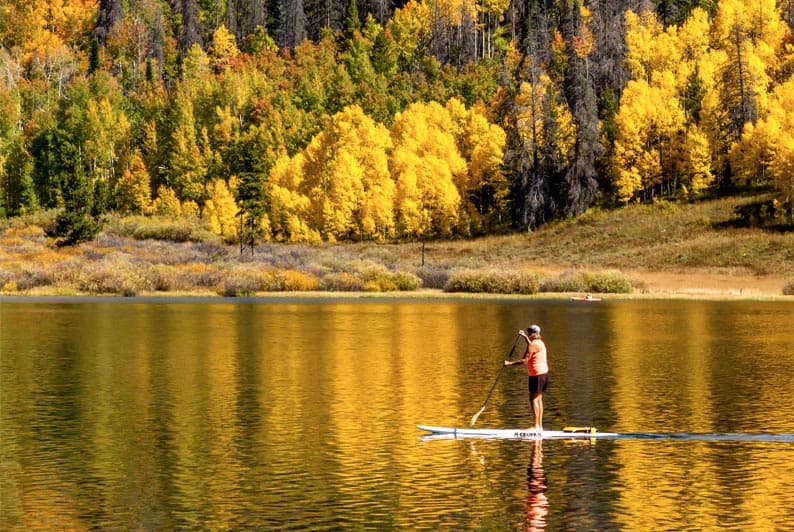
If you love nature and want to see it in a way like you’ve never seen it before, then grab a board and a sup paddle and jump in. Paddle boarding allows you to be figuratively and literally immersed in nature. On a board you are given the chance to experience the ebbs and flows of streams, lakes and oceans. As water laps at your feet and toes you are able to experience nature and its creatures on a more intimate level. We begin to reconnect and our sensitivity to issues surrounding both our local and global environment can become heightened.
5. Improves your Balance
There’s a reason why paddle boards are BIG! If you’ve ever tried surfing, you’ll know that standing up on a surf board is really hard and takes a lot of practise.
This is why beginner surfboards are much bigger than what a pro would use. The larger the surface, the more stable it is, and easier it is to stand on without falling off. That being said, as a beginner on even the largest paddle board, you can expect to get wet numerous times before your body and mind start to coordinate.
When the balance comes though, it’s like riding a bike, and the feeling is awesome.
Enjoying this article? You might also like:
6. Helps you to Relax
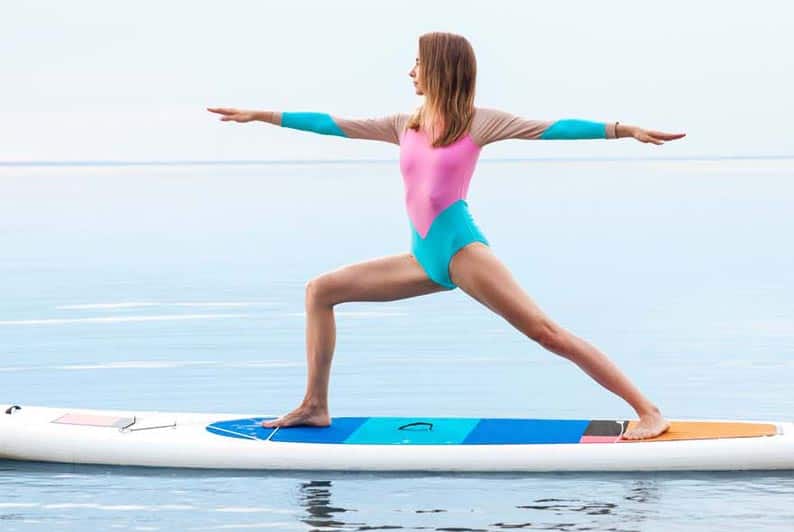
In a recent interview actor, director and Golden Globe award winner Edward Norton remarked “There’s just something about moving water,” when asked about his experience surfing. Even though he was talking about surfing, paddle boarding offers the same sensation and experience. Gliding on top of flat water so calm that you would be hard pressed to tell the difference between it and a mirror can be a cathartic experience.
SUPing opens up a world of new possibilities out on the water. Did you want to get some exercise in? Distance paddling is good for developing muscular endurance and entire yoga classes are now being held on paddle boards. Looking for a new perspective on fishing? SUPs are being specifically built for fishermen with rod and paddle holders, built in live wells and anchor stakes.
7. Improves your Posture
They say that in today’s society “sitting is the new smoking.” Much of modern society is sedentary throughout the day and are constantly hunched over keyboards, paperwork and desks. This leads to a whole host of back and mobility problems with the end result being a highly compromised posture. There have already been cases reported of bulging discs as a result of excessive smart phone use.
Taking up an activity like paddle boarding can help alleviate the strain you put on your posterior chain and spine. The actions and movements required to keep you upright serves to strengthen the muscle groups that are responsible for maintaining a good posture.
The biceps femoris, gluteus maximus, erector spinaes and trapezius are all included in the muscle group known as the posterior chain. The simple act of standing on a board on water and paddling will do wonders for your posture.
8. Is a Great Platform to Fish from
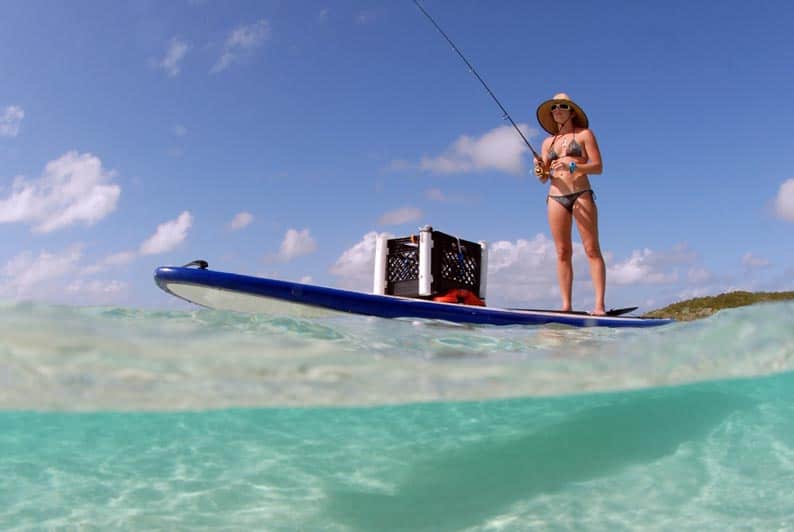
For all the anglers out there, paddle boarding gives you a new platform (literally) to get on top of some fish. The mobility of paddle boards can help you get into fishing spots that can ground a boat or put a hole through a canoe. Not only that but it is very stealthy too, since it lacks a noisy motor nor does it have a clunky hollow hull. Fishermen also find the standing aspect of paddle boards (an act that is difficult to replicate on unstable canoes or kayaks), a much welcomed benefit as it allows them to better locate fish from the surface.
Fishing on SUPs has become so popular that many manufacturers have released models of paddle boards with the angler in mind. These SUPs usually sacrifice speed for stability and are wider to accommodate the moments where a fisherman has to fight with their catch. Additional features may include built-in tackle boxes, bungee rigging for supplies or a cooler, and rod holders for trawling. So next time you grab your rod and reel, think about grabbing a board and paddle as well.
9. Paddle Boarding is not Expensive to Get Started
Unlike most other water sports you don’t need a lot of money to get out there and start paddle boarding. Thanks to the popularity of surfing throughout the decades, boards are more affordable than ever along with a multitude of paddle board accessories, with some entry-level boards going as low as $400 USD. The rise of inflatable SUPs, made out of tough and durable whitewater rafting material, gives consumers a convenient and portable option, with some starting at a mere $500 USD.
That’s an entire SUP that you can roll up and throw into the trunk of your hatchback or hike into an alpine lake for half the cost of a standard bulky canoe, and a fraction the cost of a motorized boat. Thanks to new developments in paddle manufacturing, prices are getting lower and more competitive every season. You can find height adjustable paddles for under $80 USD at several major retailers. The barrier for entry for SUPing is so low it is a wonder why more people are not taking to the water.
10. Can be a Great Source of Competition
If you have a need for speed and races, but are tired of the usual ground events then pay attention. SUP race events are popping up all over the world. Encompassing everything from short sprint type races to multi-day open water endurance comps, you can now scratch your race itch on top of the water too. There’s something for everyone from novice to pro, from flat water paddler to open ocean racer to whitewater warrior.
Take the Payette River Games for example. Held in Cascade Idaho, pits paddlers to race against each other in the gushing whitewater of the Payette River. Then there’s the Battle of the Paddle, the SUP worlds Super Bowl, which is easily the biggest and most competitive race of the year.
Finally, there is the prestigious Molokai-2-Oahu (M2O) race. Let’s face it who doesn’t want to participate in a race across two Hawaiian Islands in the Pacific? But all great journeys begin with a single step, grab your board today and get those practice hours in.
11. Paddle Boarding Offers Variety
One of the amazing things about paddle boards is that it can cater to any preference. You like going fast? No problem, there are keeled SUPs that can cut through the water and can provide you with the smoothest ride even in the presence of rough water. Want to go lake cruising but tight on budget? A standard flat bottom board is right up your alley and won’t break the bank. If you can imagine a day on the water, then a paddle board can get you there.
From cruising streams and rivers, to open water crossings the sky is the limit. Speaking of sky, if you ever wanted to paddle on a high mountain glacial lake why not carry an inflatable SUP on your back and make that dream into a reality. The range of possibilities spans the entire spectrum from ability, to budget, to activity type. The choice is in your hands.
12. Is a Great Focus for Adventure and Travel
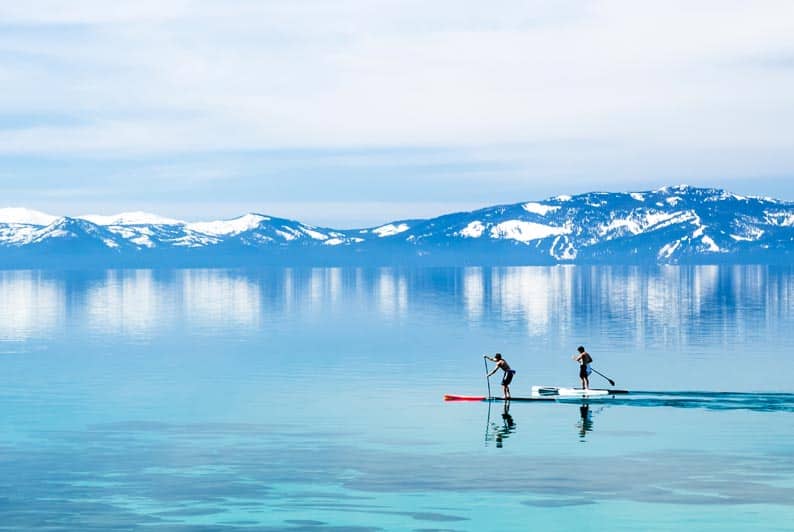
Adventure can be found and experienced while riding a SUP, just ask British adventurer Dave Cornthwaite who paddled the entire length of the Mississippi River. Cornthwaite spent almost 3 months paddling over 3,000 miles from the headwaters in Lake Itasca, Minnesota to the Gulf of Mexico. Paddle boarding can open a whole new world of travel and adventure for those willing to seek it.
Have you ever wondered if it was possible to camp across the lake or what lay beyond the bend in the river? With paddle in hand and board under foot, you can answer your own questions. Float your way to hard-to-reach areas, explore new shores and embark on epic aquatic voyages. Let your imagination soar and then paddle your way towards them.
If adventure is what you’re looking for, then open water keeled boards developed to provide the best ride in the ocean may be what you’re looking for. Or, if rough rivers are more your thing, there’s a board for that as well. The sky is the limit when it comes to stand-up paddle boarding, and it has never been easier or more cost-effective to get into this sport and activity. So why not give it a go and you’ll soon discover how to stand up paddleboard!
The same can be said about drifting along a river bend and watching nature pass you by. It can literally take you to places where it’s just you, nature and your thoughts. If your version of relaxation involves some action, then try doing yoga on a paddle board. Both body and mind need to work in concert to complete you poses and stay dry. It is an exercise in awareness and mindfulness that you should not miss.
13. Paddle Boarding can be Good for Socialising
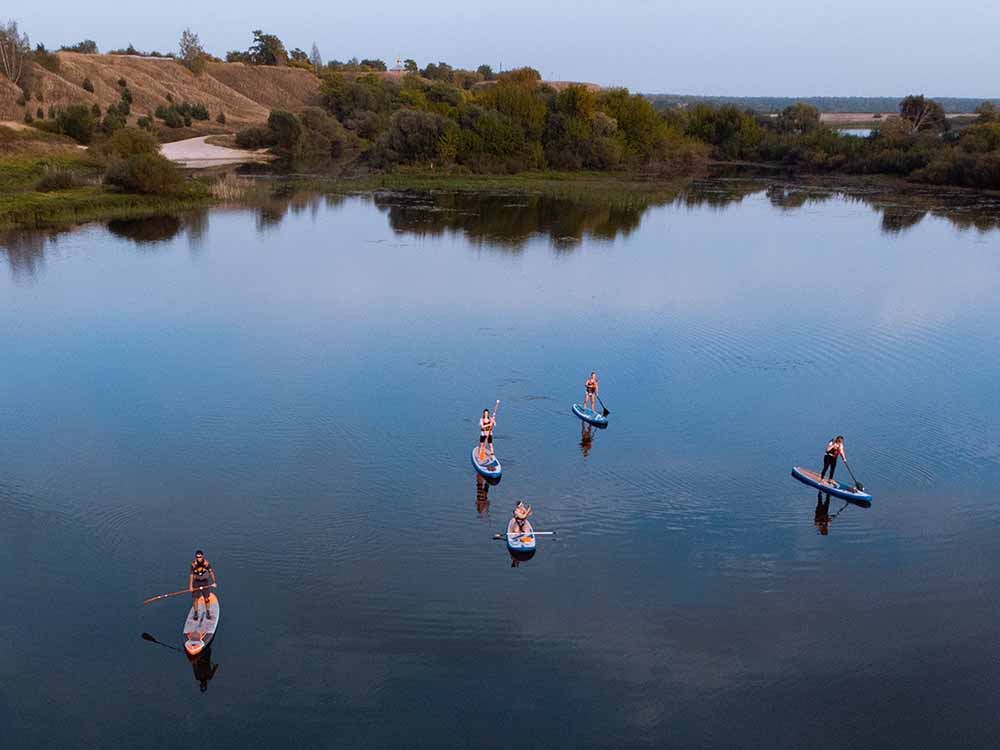
At the end of the day the majority of people who pick-up paddle boarding do it because it is enjoyable. It is fun and makes them happy when they wade into the water with paddle in hand and board in tow. That joy and happiness only grows when you share the experience with your friends and family.
Besides getting a good group workout, SUPing with those your care about allows you to share an experience that cannot be replicated on land. The freedom and exhilaration of adventure coupled with the camaraderie and bonds that hold you and your circle together are priceless. Paddle boarding gives you the opportunity to transport you and your group to intimate settings and experiences that your group will remember and talk about for years to come.
Why is Paddle Boarding so Popular?
For the majority of people, Stand Up Paddle Boarding is a bit of a curiosity and for many this is enough for them to give it a try. These days, more and more SUP schools are popping up on ocean sides, lakesides and rivers around the world. While some see it as a new activity that they can sink their teeth into, others view it as a new sport to dominate. But, no matter what your motive is for getting into this great passtime, everyone feels the benefit in some form.
Curiosity may be the reason why most people first step foot on a paddle board, but fun is what keeps them on it. SUPing is an extremely rewarding activity. Besides spending time with friends and family doing a worthwhile activity, learning to stand up paddle board has the potential to benefit you on a personal level. While it may look effortless to glide through the water while standing on a board, the act is surprisingly engaging.
Paddling, while standing on top of a board on water, requires a great deal of coordination. Various muscles in your lower and upper body must work in unison to keep you standing, as well as propel you through the water. Due to this, SUP has also been seen as a legitimate way to develop strength, correct posture and improve coordination. All this, while enjoying nature at the same time. No wonder it has caught on around the world, there are numerous benefits for everyone.
We’ve compiled what are viewed by many as the most profound, and for individual reasons, some are more important than others.

